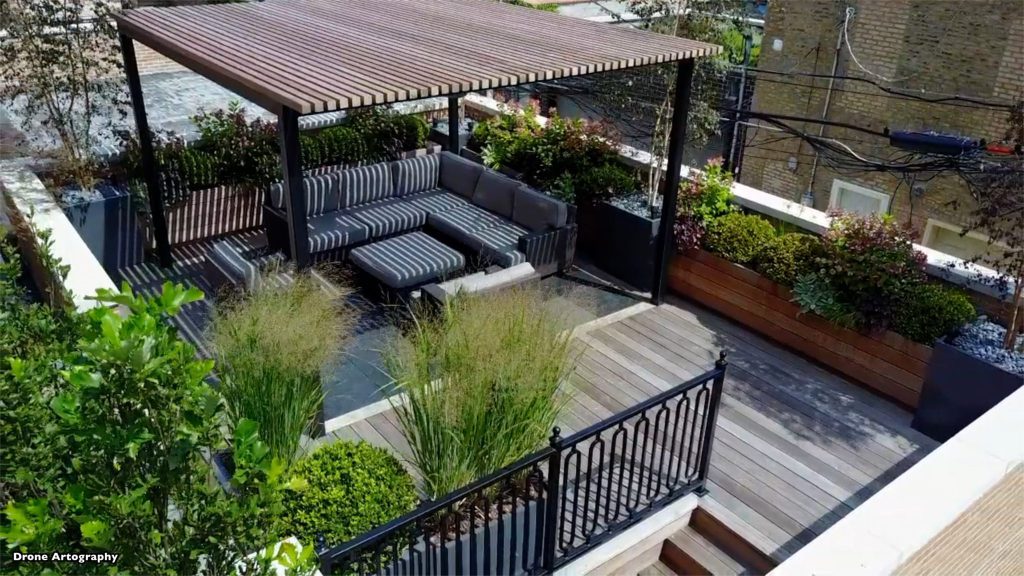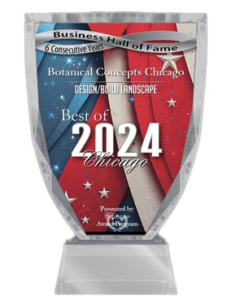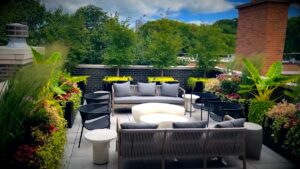Chicago’s roof decks are often underutilized spaces that most owners overlook. But a really good (and unorthodox) way to revamp your otherwise drab rooftop is to start a roof garden or sky garden.
But how do you go about creating one?
How to Start a Chicago Roof Garden
- If you are in a shared building, the first step should be to check with the landlord or building superintendent about attaining roof rights, or to ask what roof access you are granted.
One of the first steps in building a Chicago roof garden is ensuring you have the proper rights and permits. Depending on your situation, you may have to petition your idea for a rooftop garden to your building’s board or council, and then you must receive approval before you can obtain rights and begin construction. Working with an experienced roofdeck design architect like Botanical Concepts Chicago will make the process go much more smoothly.
Get a Free Chicago Roof Garden Consultation - Once rights have been secured, it is important in this stage to get in contact with a contractor or the building engineer to assess the condition of the roof and help establish a list of necessary finances. If you decide to tackle this project solo, you alone will bear the burden of all insurance costs, maintenance fees, materials and other expenses.
For those in shared buildings, a homeowner may look to share the cost with another resident in the building who is interested in the project as well. - After your finances are in order, the next step is to develop a plan. There are several things you must consider before rushing off to the nearest home and garden store, such as the layout of your rooftop, how many planter beds you’d like to have, whether or not you’d like raised containers, what kinds of plants you intend to grow, etc.
It is important that you opt for sturdy materials, such as large half-barrel or concrete planters, which are unlikely to dry out or topple over under windy conditions, and raised beds that are at least 10-inches deep, to allow for proper root growth.
In addition, you must also find a water supply. Especially during the summer time, garden beds must be watered frequently. If desired, automatic watering systems can be installed to alleviate the constant lugging of watering cans up to the roof and back.
What Kind of Plants Can You Grow on Your Chicago Rooftop?
By now, a question you have in mind is “What kind of plants will grow on my Chicago roof garden?”
For those who are unaware, most of Illinois has a hardiness level of 5. Hardiness refers to a plant’s ability to tolerate certain temperatures. Zone 5 plants must be able to survive winters where temperatures are as low as -10 to -15 °F.
Most zone 5 gardeners wait until early to mid-May to plant vegetable and annual beds, both of which do very well so long as they’re not hit by late frost while young.
Plants that do well in this area include perennials like Echinacea, Phlox, Lillies, Poppies and Salvia. Most of these flowers are vibrant purples and pinks and will bring a lively, exuberant feel, and pleasant smell, to your rooftop.
If produce is more your style, carrots, beats, tomatoes, chives, parsnips, and spinach, among others, do well in zone 5 areas. Garlic, thyme, and sage would also fair well in the Chicago area.
The list of plants and vegetables is long. A quick Google search will yield more possibilities for your garden, so it’s worth checking out for more ideas.
While this may all seem daunting for most homeowners, hiring an experienced Chicago roof garden design & architectural company can cut down the uncertainties and maximize your time and budget.
Frame the Cityscape for the Ultimate Chicago Roof Garden
Rooftop transformations are becoming increasingly common in densely populated urban areas such as Chicago, New York City, Los Angeles and Miami. Their tranquility provides a much needed respite from the day to day chaos of the fast paced city and can be utilized for outdoor living, as an entertainment area or as a tranquil green roof for growing plants and escaping the city.
Although these types of rooftops provide numerous advantages for their owners, there are specific factors to consider during the design process. However, with some careful planning, it is straightforward to develop a vibrant rooftop getaway that enhances the stunning skyline vista while providing tranquility for maximum enjoyment.

What are the Benefits of a Rooftop Garden?
Cultivating a lush green roof presents numerous advantages for the gardener, including enhanced well-being and decreased stress, along with a boost in air quality. However, there are myriad distinct perks and benefits. Among the most significant motivations for establishing a rooftop garden are its climatic and environmental advantages.
Typically the rooftops of urban buildings are barren and the weather can affect the surface harshly; covering the roof in greenery and shade can help to lessen this impact. Having a “softer” surface on the roof will also act like a natural insulator for the building; it will help to reduce heating costs in the winter by holding heat within the building when it’s cold and cooling costs in the summer months by deflecting the hot summer rays when temperatures climb.
Having plants on the roof will also help to reduce the storm water runoff considerably and in turn decrease negative effects seen from the water draining to the street below.
In some circumstances your new deck may qualify for LEED credits. Between this and the reduced utility bills, it’s easy to see why people are putting in rooftop spaces!
Roof Garden Planning & Considerations
When planning your Chicago rooftop there are a few things to bear in mind, especially if the skyline is to be kept open.
- It’s important to decide if the space will be dedicated only for growing plants, or if it will function as an outdoor living space as well. Having a seating or hangout space will make the area more multi-functional, but planning for these design installs will be much easier in the initial design consultatation.
- Think down the road. More often than not plants are bought when they are immature, and still have growing to do. Pay attention specifically to what the height of mature plants will be and work with specimens that tend to stay more compact or dwarf to keep from impeding the view.
- Mix plant types to provide some variety in the design. Shrubs, ornamental grasses and flowering perennials can be interspersed among the ornamental annuals and vegetables to add to the design.
- Build raised garden beds to add a small amount of vertical height within the design. Putting the beds on casters or spacers to keep the bottoms up off the roof will prevent roots from growing through and in turn damaging the building’s roof.
- Start with a main focal piece in the planning process and design everything else around that. It can be something like a water feature, a stunning plant specimen, or even a gorgeous piece of pottery used as a container. Having a main focus will help to tie the entire design together.
- After the main focal piece is decided upon, then it’s best to limit the entire design to no more than 3 colors. Choose one for the primary design element, with one or two others acting as accents. Too many colors in the design elements – furniture, containers, walls, flooring – can cause the space to look cluttered and busy. Neutral colors like beige, white, and grey make good accents and help draw out the beauty in the plants.
- If the deck will function as a living space, or will be used for entertaining, it’s important to consider some lighting solutions so it can be enjoyed after dark. Ambient lighting will create an inviting, relaxing atmosphere after dusk and extend the time the space can be utilized. Be sure to make it a little brighter by the stairway or door for safety reasons.
By implementing a few straightforward planning and design ideas, it’s simple to establish a beautiful, thriving rooftop design that offers a serene, green retreat!
Botanical Concepts is an award winning Chicago Roof Deck Design Company who can help you with your roof garden project. Schedule a consultation today.



